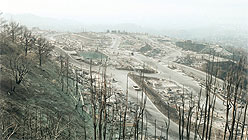In simultaneous shows at the Oakland Museum of California and the Berkeley Art Museum, Richard Misrach exhibits for the first time a 20-year-old collection of photographs in 1991: Oakland-Berkeley Fire Aftermath. The images, taken by Misrach in the weeks immediately following the firestorm, document scenes of devastating destruction, capturing in still and un-peopled frames the markers of ferocious violence.
Driving through the recently cleared streets, Misrach made 200 exposures on an 8-by-10-inch view camera and then tucked the negatives away. In a decidedly anti-commercial move, he chose to categorize his Oakland-Berkeley fire photographs as historical documents that needed to be protected. Fearing they would simply become part of the news cycle if released at the time, he was also curious about their ability to remain relevant in the long-term. “It was a gamble,” he said at a recent preview event, “to think that 20 years from now, people would be interested.” Fortunately, in his (and my) opinion, the images “have stayed strong and true,” despite being sequestered in a time capsule for the past two decades.

The images on view in OMCA’s darkly-lit gallery are large and luminous. (Berkeley’s exhibition differs only slightly in content, but vastly in setting: their galleries are tall white cubes.) The collective color palate is what one would expect — ashy grays and charred black branches — but moments of unexpected color pull the viewer around the room. The showstopper of the exhibition is an 8-by-10-foot close-up of a child’s tricycle, its orange, yellow, and blue plastic melted grotesquely. The enormity of the print (nearly floor to ceiling) envelops the viewer completely.




